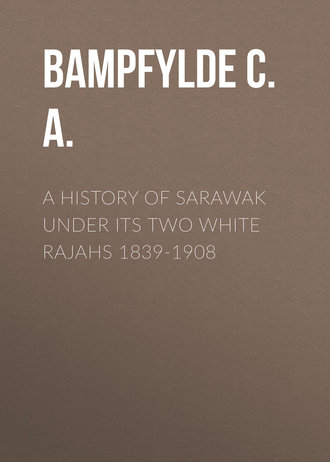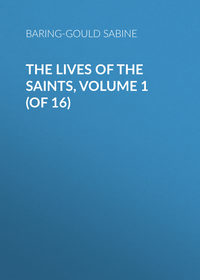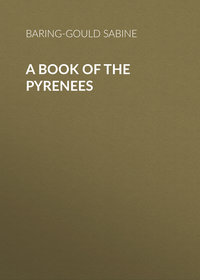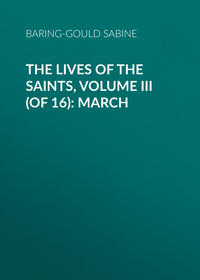 полная версия
полная версияA History of Sarawak under Its Two White Rajahs 1839-1908
That the system of government in vogue in the Federated Malay States and the Straits Settlements is irreproachable cannot be denied; but at the same time it cannot fairly be contended – in the face of all evidence to the contrary – that it is as well adapted to the requirements of Bruni as is that in vogue in Sarawak, a system which the editor admits "is an object lesson in administration," and which his local contemporary, the Singapore Free Press, has before described as "a government for natives second to none."
What are "the larger interests involved" which appear, in the editor's opinion, to have necessitated the handing over of Bruni, against the wishes of the people, to a government foreign to them? The editor answers the question with a prophecy, which, unless it emanates from his own fertile brain, throws light on the policy of the British Government, and hints at a possible disregard of fair-play and treaties, which has only been made possible by the acceptance of British protection by Sarawak. The British Government as far back as 1863 fully acknowledged the independence of Sarawak under the rule of its white Rajah, and the agreement of 1888, by which the State was placed under British protection, was not intended, nor accepted, as one which would militate against that independence, and such a possibility can scarcely be construed as following in the train of that agreement.
CHAPTER XIV
THE SEA-DAYAKS
In an address to the Council Negri in 1891, the Rajah said that he might divide his term of service of thirty-nine years into three periods of thirteen years each. The first period had been almost wholly devoted to the work of suppressing head-hunting among the Dayaks, involving frequent expeditions by sea and by land, and a life of carrying arms and keeping watch and ward against subtle enemies. The second period had been divided between expeditions of the same nature, and the peaceful pursuits of giving or amending law, and the establishment of its supremacy. And the last period had been almost entirely taken up with attending to the political and social affairs of a settled and peaceful country. Those present who had been young with himself during the early days of his service, had been strong and able to carry through the work set before them, rough and perilous in the extreme, in mountainous regions of jungle, subject to every kind of exposure; but now these hardships were no more required, and that was well, for both they and himself were waxing old. The character of his task was changed – he and his old comrades on river and rock and in jungle could sit in their arm-chairs, and attend to the political business and the commercial progress of the country.
To these periods the Rajah has since added a fourth, and that the longest of all, during which much has been done to extinguish the lingering sparks of racial and intertribal hostility. These still break out occasionally amongst the Sea-Dayaks, though at wider intervals, as time goes on, but are confined to the remote interior, and to a very limited district within the State and over the borders, of which Lobok Antu is the centre. These occasional outbreaks, which but reveal the old Adam, do not trouble or affect those living outside this district, and indeed do not stir their interest any more than the border troubles in India affect the population of that country generally.
It is an Arab proverb – Be content with bread and scrape till Allah sends the jam. The first Rajah certainly had very hard scrape, and in the first periods of the second Rajah's career, he had to be content with bread and scrape, only slowly, though surely, came the jam.
The Ulu Ai329 Dayaks, or, as the name implies, those inhabiting the head-waters of the Kapuas, Rejang, and Batang Lupar, are nowadays the sole offenders, and although they lead others astray, these troubles involve but a small proportion of the Dayak population, but five per cent, or one per cent of the entire population of Sarawak.
A quarter of a century ago, Malays were forced to live together in villages, for their protection against the Sea-Dayaks, and were constrained to move in strong and well-armed parties when visiting these people for the purpose of trade. Now they occupy scattered houses on their farms, where they can make gardens and plantations, and they mix freely with the Dayaks without the least fear.
But even the Ulu Ai Dayaks, in spite of their occasional lapses, are far from being inimical to the Government, for which they are ever ready to work, and which they will as readily follow. At all times, its officers, English and Malay, are quite safe amongst them, and are received with respect and cordiality. Punishments, however severe, are submitted to, and do not affect their feelings towards the Government. On the whole these Ulu Ai Dayaks are well disposed, but they allow themselves to be led astray by the more unruly and restless spirits in the tribes; yet even of these latter, some have been brought to become staunch supporters of the Government.
The Saribas Dayaks, formerly the most malignant and dreaded of pirates and head-hunters, and the bitterest opponents of the Rajah, have long since become the most peaceful subjects of the State, and have developed into keen traders and collectors of jungle produce.
The Sekrangs, with the exception of one outbreak, noted on page 381, for which a treacherous Government chief was solely responsible, have been as peaceable and law-abiding as the Saribas. These, with the Undups and Balaus, ever the faithful friends of the Government and the bravest – "a more plucky and sterling set of bull-dogs there is not to be found," the Rajah wrote of the former many years ago – are now the best-disposed people in the State. With them perhaps may be included the Lemanaks, and the Engkaris, who, however, have not gained for themselves the same character for straightforwardness. The Ulu Ai are alone the peace-breakers. Physically these men are the finest of all, but are coarser in manners and not so brave. All these tribes, with the exception of the Undups and Balaus, having greatly multiplied, have spread over Sarawak, and become much mingled.
Besides being very intelligent, the Sea-Dayaks are wonderfully energetic and hard-working. They are thrifty, eager to become well-off, are honest, and have few vices; but they lack channels for their energy. Regular employment in their own country by the establishment of industries, such as plantations and mines, would do more for their redemption from savagery than years of labour among them by officials and missionaries. At present, their energies are almost entirely confined to working jungle-produce; though to seek this, they have now to go into the far interior, and this is often the cause of their getting into trouble with remote and wild tribes; they go also to North Borneo, Dutch Borneo, Sumatra, the Malay peninsula, and even as far as Mindanau, in the Philippines. These countries they visit in large numbers, and abroad their honesty and energy have gained them a good character. Many Dayaks place the money they have saved with the Chinese on interest; some have erected shops, which they let for rent; but with most the prevailing idea of riches is an accumulation of old jars and brassware. There is no man keener on the dollar than the Dayak, or keener upon retaining it when gained; and there is no better labourer, but the employer of Dayak labour must be tactful and just. As they become more prosperous they discover for themselves that it is more conducive to their welfare not only to be on good terms with the Government, but at peace with their neighbours.
The Dutch in the Kapuas have experienced considerable difficulty in dealing with the many tribes of different races, especially with the Sea-Dayaks, who inhabit that vast river, which runs past the heads of the Batang Lupar and the principal left-hand branches of the Rejang river, but they have made some advance in the pacification of these people, though their methods are very different, far less energetic and much slower, than those of the Rajah.
The highlands, the spine of Borneo, along which runs the frontier, is no mountain ridge, but a broken upland district, that forms the watershed of the great rivers of Sarawak on one side, and the still greater rivers of Dutch Borneo on the other. It is a region difficult of access from the coast on both sides, and long after the Dayaks living lower down had become peaceful, turbulence and internecine warfare remained chronic in the interior. And this was the more difficult to suppress because the aggressors had but to step across the boundary, where they could not be pursued by the forces of the Rajah. This was perfectly well understood by these savages, and was taken advantage of repeatedly, and the efforts of the Rajah were in consequence continually thwarted.
A series of expeditions was planned by his Highness that for this reason met with but partial success. It is unnecessary to record the details of each, for each repeated the experience of the former with painful iteration, and we have already given an account of some of the earliest of these punitive expeditions. But it will be necessary to record them, to show how great were the difficulties the Government had to contend with before the turbulent tribes of the interior could be brought to submission.
A great many of the Ulu Ai Dayaks had settled in the Katibas river, which is the highway from the Rejang to the Kapuas river in Dutch territory, and these Dayaks were incessantly giving trouble by making predatory raids against their enemies over the border.
The Dutch had complained of this, and the Rajah had attacked them in 1870, as we have recorded, but as they continued to give trouble, he again attacked them, for the third time, in July 1871, taking them on this occasion completely by surprise; and driving their chief, Unjup, over the frontier, where he might have been captured. Unjup was the brother of the powerful chief Balang, who had been previously executed for plotting against the Government.330 Later on he was allowed to return, and was pardoned on making humble submission. He subsequently became a Government chief or pengulu, but he was a useless character. After the third attack, this tribe was moved to the lower waters of the Katibas, and an interval of uninhabited jungle was put between them and their enemies.
However, what is born in the bone must come out in the flesh, and, in 1874, they again broke away and attacked, on this occasion the Tamans and Bunut Malays of the Kapuas. It was, however, a case of lex talionis; and these people had brought it upon themselves by their own treacherous conduct in inveigling six Dayaks, who were on a peaceful visit to their country, into a Taman house, where they were seized and bound. Thence these six had been sent to Bunut, a large Malay settlement, and were there put to death in a most cold-blooded manner. Nevertheless the Dayaks had to be taught not to take the law into their own hands. But properly the Netherlands officials were the most blameworthy for not having promptly secured and punished the Malay murderers and their accomplices.
The following year the Batu Bangkai Dayaks of the Kapuas, in conjunction with some Katibas Dayaks, made a determined attack on the Lemanak Dayaks. The Lemanak is a confluent of the upper waters of the Batang Lupar. The repeated outbreaks of these turbulent natives was entirely due to their proximity to the Dutch frontier, and to their knowledge that they had but to step across the border to escape the Government forces; and at that time the Netherlands Government insisted upon the border rights being strictly respected; moreover their troops, the only forces they had at their disposal, were totally useless in acting against Dayaks, who can only be tracked by fellow Dayaks. The Netherlands officials in the Kapuas were themselves aware of their inability, and were averse to the policy of their Government. Powerless themselves, unwilling or unable to use Dayak auxiliaries, they were well content to let the Rajah do the work for them which they could not do themselves. But the central Government objected.
The Ulu Ai Dayaks of the upper Rejang, after having been peaceable for many years, were encouraged by these circumstances to break out again, and even those who were disposed for peace were terrorised into joining in these forays by a threat of having their houses burnt down over their heads, unless they came out upon the war-path.
In October, 1875, the Rajah led a large force against the upper Batang Lupar Dayaks, who had been giving great trouble, and forty of their villages were destroyed; but deeming this punishment inadequate, the attack was followed up by another delivered two months later; the rebels, completely surprised, suffered severely, and hastened to tender their submission.
The turn of the Katibas was to follow shortly. The Kapuas Dayaks over the border were still unchecked, and knowing how incapable the Dutch officials were to subdue them, and secure as they believed themselves to be behind the frontier, they became insolent, and in February collected a large force of over 2000 fighting men to punish the Dayaks up the Batang Lupar for having submitted to the Rajah. They came within two hours' march of Lobok Antu fort, but here they found the Resident of the district at the head of a large force blocking their way. The Dutch Controleur in vain endeavoured to persuade these Dayaks to disperse and return to their homes; and they had the insolence to send the Resident an intimation that they would do so if he paid them a fine of eight old jars, and declared that if this were refused, they would attack Lobok Antu in force. As the Resident could not cross the border to punish them, this was just what he wanted them to do, and he was perfectly prepared to give them a hot reception. But they changed their minds and withdrew, leaving him greatly disappointed that he had not been able to administer to them a much-needed chastisement.
But these Dayaks were not to be allowed to play fast and loose much longer, for towards the end of 1876, the Resident of Western Borneo administered a severe lesson to the rebels, destroying all their villages and killing a great number of the men. His expedition, conducted with vigour and thoroughness, was completely successful.
In October, 1876, the Rajah for the fourth and last time attacked the Katibas Dayaks with a small force of about a thousand Dayaks and Malays. This led to the submission of these people, and they were forced to leave the Katibas river, and move to the main river. Since then no Dayaks have been allowed to live on the Katibas, and from the Rejang side the border troubles almost ceased.
Early in 1879, led away by their principal chief, Lang Endang (the Hovering Hawk), a Government pengulu, the Sekrang Dayaks prepared to attack their old enemies, the Kantu Dayaks, in Netherlands Borneo. They were prevented in time, information of their purpose having been conveyed to the Government. Their war-prahus were destroyed, and a heavy fine was imposed upon them. Lang Endang, whilst professing loyalty to the Government, was secretly inciting the Sekrangs to resist, and they refused to pay the fine. Lang Endang offered to attack the recalcitrants if a party of Malays was sent to support him, but, as the Government was well aware that treachery was meditated, the offer was declined. Acting under instructions from headquarters, the Resident entered the Sekrang at the head of a large body of Malays and Kalaka, Saribas and Batang Lupar Dayaks in April. Lang Endang had assured the Government that he would not allow the Sekrangs to make a stand in his district, but at the same time he had collected them secretly around his long-house, and his plan was to fall on the Government bala and take it by surprise. This he succeeded in doing. A large horde of armed savages surrounded the punitive force and attacked it, but the Sekrangs were badly worsted and lost many killed and wounded; the Government forces advanced, driving the rebels before them, and Lang Endang's village was burnt to the ground. The Sekrangs then submitted, paid the fine, and deposited pledges for future good behaviour. Lang Endang was declared an outlaw. He was driven from one place to another, and although he was burnt out several times, he managed to escape with his life. Finally he was suffered to settle by himself in the Kanowit, a broken-down old man, without power to do more harm. The Sekrangs had for many years been the Rajah's devoted followers; since this final outbreak they have given no more trouble, and have regained their good character.
After the establishment of the fort at the mouth of the Baleh, since removed down to Kapit in 1877, the Ulu Ai Dayaks gradually moved into that river, and in 1880, it was thickly populated by them. Scattered among the numerous Dayak villages on this river were small parties of refractory Dayaks, who had been guilty of several murders to obtain heads, and with heads renown. Though the majority of the Baleh Dayaks were well affected, and had no sympathy with these young head-hunters, they refused to give them up. Thereupon they were offered two alternatives, either they must surrender these murderers, or else move from the river to the lower waters and leave them and their followers to their fate. They chose the latter alternative. Then the refractory party retired up the Mujong branch of the Baleh, and established themselves at the foot of a lofty, precipitous mountain called Bukit Batu. Upon an almost inaccessible crag of this they erected a stockade, to which they could retreat in the event of being attacked, and draw up their ladders after them. Here they considered themselves to be secure from punishment, and in a position to raid neighbouring tribes, carry off heads, and to defy the power of the Rajah. To prevent this and to cut off their supplies, a stockade was built at the mouth of the Mujong, and again another at the mouth of the branch stream that flowed from the mountain. A few were intimidated and came in, but the rest, though they suffered great privations, held out and evinced their determination not to surrender by cutting off three Malays, who incautiously had left the upper stockade to go fishing. They were attacked by the Rajah in February, 1881, several were killed, and their houses were burnt down; but this punishment proving ineffectual, the Rajah again attacked them in the following September, when they suffered heavier losses. After this second lesson they sent in their women and children as hostages and tendered submission. Then Bukit Batu was abandoned to its original inhabitants, the wild Punans; and the Dayaks were not allowed to live any more in the Baleh.
In 1884, a large force of Seriang Dayaks from Netherlands Borneo, under the leadership of pates, chiefs appointed by the Dutch Government, attacked Padang Kumang, also on the Dutch side, killing nine and wounding five more, and in this expedition they were joined by a Batang Lupar Ulu Ai chief, Ngumbang, with 300 followers. A heavy fine was imposed upon Ngumbang, and he was ordered to remove farther down the river, where he could be closely watched. He refused to pay and to move, on the plea that the Dutch Dayaks had been the originators and leaders of the raid, and that he did not see why punishment should fall on his head, whereas they were allowed to go scot free. Similar attacks continued to be made, not only on the Kapuas side of the frontier, but also upon the Lemanaks and Sekrangs on the Sarawak side, and the whole of this part of the country was in a ferment and disorder. On Kadang ridge, upon the border, and in its vicinity, numbers of unruly Ulu Ai Dayaks had settled, some on one side, some on the other, taking advantage of their position to slip across when fearing molestation. These Dayaks were being continually augmented by impetuous young bloods eager to acquire reputation for bravery. Nothing could be done to reduce them without the consent, if not the co-operation, of the Dutch authorities, and the Rajah applied to the Netherlands Government to permit him to disregard the border, for this once at least. And as this hornet's nest had become a menace to the peaceful in Dutch Borneo as well as in Sarawak, consent was given.
In March, 1886, the Rajah advanced against Kadang with a large force of 12,000 men. The whole country in the vicinity of Kadang on both sides of the frontier was laid waste; eighty villages were burnt, and although the rebels made no determined stand, many were killed or wounded. This expedition was eminently successful, as it not only resulted in the submission of the rebel Dayaks on the Sarawak side, including the chief Ngumbang, but also caused consternation among those over the border, who found that they were no longer safe there, and they were prepared to submit to any conditions the Rajah might impose upon them, rather than incur the risk of another attack.
In appreciation of the signal services rendered to the country under his control by the success of this expedition, in September, 1886, the Netherlands Resident of Western Borneo wrote to the Rajah: —
Yesterday I received from the Comptroller the important information that the last inhabitants of Bukit Kadang, who till now have refused to submit, have been taken prisoners and brought to Sintang,331 where they will be tried before the competent judge. On Netherlands Territory in the frontier lands there are now no more rebellious Batang Lupars. Whilst congratulating you once more, dear Rajah, with this result, being due to the success of your expedition, I assure you that my functionaries will always earnestly co-operate for the conclusion of the Batang Lupar question.
The united efforts of the Netherlands and Sarawak Governments have done much towards suppressing the border troubles. A clear understanding has been arrived at in regard to the mutual management of these turbulent Ulu Ai Dayaks. The Netherlands and Sarawak officials frequently correspond and meet to discuss arrangements, and the assistance afforded by the former has been fully recognised and acknowledged in the pages of the Sarawak Gazette.
Not only in connection with these particular border-troubles, but in all other matters, the relations between the two Governments have for years past invariably been conducted in a spirit of mutual consideration and support, and with a wholesome absence of red-tapeism.
On June 27, 1888, in Lobok Antu fort, peace was formally made in the presence of the Netherlands and Sarawak officials, with the usual ceremonies of pig-killing between the Ulu Ai Dayaks and the Malohs of Kapuas, thus bringing to an end a feud that had existed for many generations, and at the same time peace was made between the Ulu Ai and the Kantu Dayaks of Kapuas. A similar peace between the Ulu Ai of the Rejang and the Malohs and Tamans had been concluded at Kapit fort a short time before.
After a long term of peace, in 1890, five young Ulu Ai Dayaks, whilst on a visit to the Kapuas, came across and killed eight Bunut Malays, but bearing in mind the former act of treachery of these Malays, the people had no sympathy with the victims; however, the chiefs averted serious consequences to their country by themselves arresting the murderers and surrendering them to the Government for punishment.
In March of the same year, some Dayaks from Samunok, on the Dutch side, made a raid into Sarawak territory and killed twelve Kunjong Dayaks on their padi-farm. Two of these murderers were killed by Dutch soldiers, and a heavy fine was imposed on the rest.
The district watered by the great Rejang river, after which it is named, is, regarding it from a political point of view, the most important one in the State; and, owing to its large and diversified population, is the most difficult to govern. It contains about half the native population of Sarawak. Into it the Sea-Dayaks have spread from the Batang Lupar, and in a lesser degree from the Saribas, and have so multiplied that in numbers they now far exceed those in the adjacent districts of Kalaka, Saribas, and Batang Lupar together, without any diminution in the Sea-Dayak population of these districts, which has for years been steadily increasing.332 Besides the many Kenyahs and Kayans, more numerous than they are in the Baram, scattered over the interior are the more aboriginal and wilder tribes, such as the Punans, the Ukits, the Bukitans, and others not found elsewhere than in the Rejang. In the old days these tribes were at feud with each other, and all were at feud with the Dayaks. The intertribal feuds between themselves have been brought to an end, but those between them and the Dayaks keep on breaking out spasmodically. These are old blood-feuds, which undoubtedly originated with the interior tribes, and arose probably from an instinctive fear of the gradual advance of a more dominant race into their country, and from a not unnatural desire to check it. So far as the main population of the Sea-Dayaks is concerned these feuds have long ceased, but with the Ulu Ai Dayaks of the Rejang, those living on the head-waters, brought as they are by their situation in contact with these interior tribes, the case is different. The Ulu Ai Dayaks have not always been the aggressors, even in recent times, but of late it has been mainly due to their vindictiveness that all attempts to put an end to these feuds have been frustrated. For this the young men have been mostly to blame, who, when away in the remote interior collecting jungle produce, and beyond even the weak control of their own chiefs, meeting with detached parties of their old foes take such opportunities of gaining renown as warriors, which awaits the return of a Dayak with a head trophy, however meanly obtained. Indiscriminate retaliation follows in the train of these acts, the victims being the first Dayaks met with, nearly always men guiltless of any hostile act, and often peaceable produce collectors from other parts of the country. So fresh feuds are established. Several wanton crimes of this nature committed by the Dayaks of the Upper Rejang led to their being attacked by the Rajah in May, 1894, all other forms of punishment, even the extreme penalty of death, having failed to deter them from repeating these acts.









